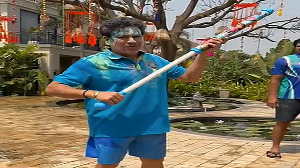Earth, Water, Fire
These three elements that define so much of human life, rose up in unison to destroy the people of Mumbai on July 26, 2005.
It poured more than it ever had in the last hundred years anywhere in the country. The city recorded almost a metre of rain that paralysed the entire city, bringing trains, cars and airports to a halt.
At Bombay High, 161 km north of the Mumbai coast, an Oil and Natural Gas Corporation oil-drilling platform caught fire while 385 people were working on that rig. Ten died and 14 are still missing.
On Versova beach in the suburb of Andheri, a group of fishermen dismantled their huts and carried them to higher ground. They were worried that they would be washed away into the sea.
 On the other side of Andheri, in Saki Naka, nature struck its worst blow in the city. Lal Bahadur Shastri Nagar is a slum colony located at the base of a hill that the locals call Khadi Number 3.
On the other side of Andheri, in Saki Naka, nature struck its worst blow in the city. Lal Bahadur Shastri Nagar is a slum colony located at the base of a hill that the locals call Khadi Number 3.
Like all slums the space between the houses here is very narrow with two paths leading up to the foot of the hill. There are houses right up to the bottom of the hill. Then there are houses on the slopes and another set of homes on top of the hill.
Most of the residents are migrant labourers from Uttar Pradesh who work in the construction industry. Others are from Karnataka, Bihar and Maharashtra.
Terrible Tuesday: Mumbai copes with a calamity
Since it was already raining heavily, all the 48 houses were full up. Those who had gone to work had returned early to beat the deluge.
Two-and-a-half hours after the downpour began, suddenly the earth caved in at Khadi Number 3, bringing down the row of houses from the top of the hill. The rolling boulders flattened the houses on the slope and buried four chawls at the ground level.
Each chawl comprised 12 houses. Each house had between 5 to 10 members. One of them being a small, thin Haseena Banu.
You would think Haseena was in school. But the mother of two stood there with her face bruised. Her hands and back injured. The child in her arms also had scratches on his chest.
But she refused to go to hospital. Her only refrain being -- "My mother is in there below the earth. I want to see my mother." Her husband advised her to go and stay with her aunt. "Your mother is not here. She is in Rajawadi hospital. I saw them pulling out our neighbour's daughter Shiraaz and the other girl Pooja. You know the one wearing the rose coloured dress yesterday. I recognised that dress."
Haseena nodded, "Yes I remember, Pooja was wearing a rose coloured dress."
Just then her brother appeared and Haseena's husband scolded him. "What are you doing here, why don't you go to the Rajawadi hospital and identify your mother, they will give you the body". Haseena said she too wanted to go to the hospital but her husband told her firmly: "They are not allowing women there."
The police had blockaded the entire area. "Sir where are the bodies that were just recovered? We want them. They are my family", a young man asked the cop. 'Which bodies are you talking about'? the sub inspector wanted to know. "Sir, we pulled them out ourselves five minutes back and now don't know where they have taken them".
The sub-inspector asked him to go to Rajawadi Hospital at Ghatkopar and assured him that he could claim the body in three minutes. "Are you sure it is Rajawadi sir, some people are saying Sion hospital."
The policeman calmly assured him that all bodies were being taken to only the Rajawadi hospital and nowhere else.
Lal Bahadur Shastri colony is on the 90 feet road in Saki Naka. The road that is usually a hub for transport operators was now full of fire brigades, municipal and police vehicles, and the Press.
The actual site of the collapse is approximately 50 square metres and the depth of the collapsed heap is around 70 feet.
Hampered by the lack of space, government staff and residents were removing sand and stones slowly. Each small boulder being handed out one at a time -- a queue of a hundred young men passing debris one at a time.
On the road outside, the debris was being loaded onto handcarts taking it further away to the main road.
The only heavy vehicle available was a huge crane that was lifting the earth, while young men were digging with pick axes and spades on the other side. They were filing small plastic sacks with rubble that were then being passed down the human chain.
Suddenly, someone pulled half a mattress out. A portion of saree came out with it but it couldn't be pulled. A boy had to cut it with a knife. The stench of dead bodies was beginning to pervade the air. Some volunteers had tied handkerchiefs on their mouth and nose.
Locals said most of the bodies recovered were of those who lived in houses on top of the hill. The inhabitants of the chawls at the ground level were still buried inside.
Pradeep Sawant who worked with a cable operator said, "These people know that this is a dangerous place in the monsoons. Every year they vacate it during this time and come back later. Some go to their relatives in other parts of Mumbai and some to their villages. But this year they did not go. They are mostly construction workers and in the rains their work is scarce".
Another local lamented: "There is this house here where four women and one boy go out to sell vegetables. Because it was pouring the women did not go. Only the boy went. He was the only who survived in that family".
The state mobile emergency column, the fire brigade, Rapid Strike Force, students from the Police training college, Mumbai Police, Mumbai Municipal Corporation workers and Anirudh Baba devotees were there on the site. Everybody was helping.
They found six bodies under a huge boulder. Much as everyone tried, the boulder could not be moved. They started digging under it and slowly pulled out four bodies.
According to the slum dwellers, six bodies were recovered on the first day and 20 people were pulled out alive.
One of the girls who had just been rescued was being carried back to the colony by her brother. She could not walk. Her body winced in pain with every step the boy took. But she was lucky to be alive.
On the second day, 50 bodies were pulled out. Today -- on day three -- so far 24 bodies had been recovered.
Rescue personnel say the exact number of dead can only be ascertained from Rajawadi hospital. And while they work, hampered by narrow paths, they risk being injured by boulders on the precarious hill, while the hill itself could collapse even further.
Some houses on top of the hill had survived but in spite of orders to vacate them, people were still in the process of recovering their belongings. Some were standing on the precipice and looking at the rescue teams at work with calm curiosity.
The cops on duty blew their whistles. People from below abused loudly but the men looked down unconcerned. They were standing right on the edge. It did not occur to them that they could cause another landslide.
Three days after the landslide only ten percent of the debris have been removed. It will take another four days to clear the place. The exact number of deaths will only be known then.
Terrible Tuesday: Mumbai copes with a calamity
Sonia visits Bombay landslide victims
Photograph: A Ganesh Nadar






 © 2025
© 2025